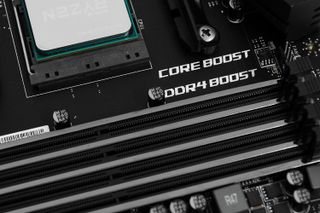
Memory Overclocking on X470 Pinnacle Ridge
In 2018, AMD launched its second-generation Ryzen desktop processors along with the accompanying top-end X470 chipset. The current Ryzen 2000-series chips, codenamed Pinnacle Ridge, are and will continue to be popular choices for many modern PC builds, even after AMD's Ryzen 3000-series processors arrival later this year. Whether you're building a budget productivity PC, a high-end gaming rig, or a professional-level workstation, there's a Ryzen chip that will suit your needs well. But if you're planning a Ryzen build around the X470 platform, then you’re probably on the hunt for the perfect memory kit to complement your system.
As the saying goes, a system is only as fast as its slowest part. Choosing a memory kit for your system should be fairly simple, but unfortunately, it isn't. Several factors, like capacity, speed, and aesthetics come into play. Selecting the looks and capacity is pretty straightforward, but choosing the right memory speed deserves more attention.
For the scope of this article, we evaluate the benefits of using high-speed memory on AMD's X470 platform with a Pinnacle Ridge processor. We test memory speeds that start from the baseline DDR4-2133 configuration up to DDR4-3466 in various scenarios. Afterward, we examine if the performance difference (if there's any) is worth spending extra based on current memory pricing.
Pinnacle Ridge and DDR4-2933
Memory support on AMD’s Ryzen desktop processors has come a long way. The first-generation Ryzen chips, codenamed Summit Ridge, officially came with support for dual-channel DDR4 memory modules with speeds up to 2,666 MHz. With the Ryzen 2000-series processors, AMD bumped the supported speed from 2,666 MHz to 2,933 MHz, a significant increase. As we know, the majority of computer hardware can perform outside the manufacturer’s specifications as long as it does so within reasonable limits. So we expect Pinnacle Ridge processors to get along just fine with memory modules that exceed AMD’s official specification, just as memory on Intel's Z390 platform can well exceed the official 2,666 MHz limit advertised by Intel.
Fiddling around with memory timings and voltages inside a motherboard’s BIOS is certainly not everyone’s idea of a good time, and AMD knows that. For this reason, the chipmaker introduced the AMD Memory Profile (AMP) standard to facilitate the entire setup process. Basically, AMP is AMD’s own take on Intel’s proprietary Extreme Memory Profile (XMP) solution. With AMP, you can set your memory to run at its advertised speed with a couple of clicks inside an AMD motherboard's BIOS.
G.Skill Trident Z RGB DDR4-4400 C18 2x8GB Memory Kit: F4-4400C18D-16GTZR
For this article, we’re using two DDR4-4400 memory kits from G.Skill's Trident Z RGB product line. Each memory kit is 16GB and is made up of two 8GB memory modules. The memory kits run at an advertised speed of 4,400 MHz with CL18-19-19-39 timings and a 1.40V operating voltage.
G.Skill produced the DDR4-4400 memory modules on a ten-layer PCB (printed circuit board) with some of the best Samsung B-die chips. Out of the box, the memory modules operate at JEDEC’s standard DDR4-2133 with CL15-15-15-36 timings at 1.20V. However, the XMP 2.0 profile baked into the memory modules enables them to operate at 4400 MHz.
Stay on the Cutting Edge
Join the experts who read Tom's Hardware for the inside track on enthusiast PC tech news — and have for over 25 years. We'll send breaking news and in-depth reviews of CPUs, GPUs, AI, maker hardware and more straight to your inbox.
MSI X470 Gaming Pro Carbon

On the motherboard side of things, we’re using the MSI X470 Gaming Pro Carbon as the foundation for our X470 testbed. MSI has equipped this particular motherboard with a decent 8-phase power delivery subsystem. There are also four DDR4 memory slots, compatible with memory modules that run up to a speed of 3,466 MHz.
The X470 Gaming Pro Carbon motherboard employs MSI’s proprietary DDR4 Boost memory circuit design. The memory slots are connected directly to the processor, so there aren't any components that interfere with the communication between both parties. The memory traces are short by nature, so there's a lower possibility of interference as well. Additionally, the memory circuit has been isolated from other motherboard components to reduce the possibility of interference further. Essentially, this design resembles a PCB that’s housed inside another PCB, with a border that divides the two.
In the field of memory traces, there’s a phenomenon commonly known as the fiber weave effect. The motherboard's PCB is basically produced with a combination of two materials, resin, and fiberglass. More often than not, the memory traces on the PCB are obstructed by the resin holes, which in turn degrades the signal. MSI’s solution plots the memory traces on the X470 Gaming Pro Carbon motherboard in a zig-zag pattern, so the memory signals are always transported over fiberglass to avoid the dreaded resin holes.
MORE: Best Memory
MORE: DDR DRAM FAQs And Troubleshooting Guide
MORE: All Memory Content
MORE: How to Overclock a CPU
Current page: Memory Overclocking on X470 Pinnacle Ridge
Next Page Test System and Setup
Zhiye Liu is a Freelance News Writer at Tom’s Hardware US. Although he loves everything that’s hardware, he has a soft spot for CPUs, GPUs, and RAM.
Most Popular

